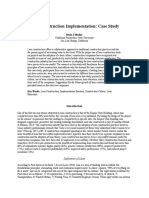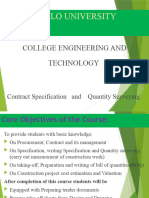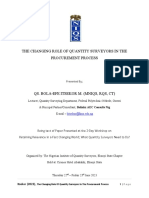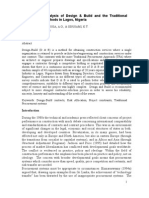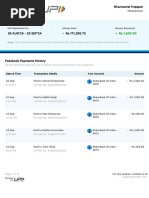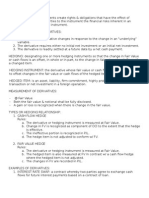An Appraisal of Project Procurement Methods in The Nigerian Construction Industry
An Appraisal of Project Procurement Methods in The Nigerian Construction Industry
Uploaded by
MimiCopyright:
Available Formats
An Appraisal of Project Procurement Methods in The Nigerian Construction Industry
An Appraisal of Project Procurement Methods in The Nigerian Construction Industry
Uploaded by
MimiOriginal Title
Copyright
Available Formats
Share this document
Did you find this document useful?
Is this content inappropriate?
Copyright:
Available Formats
An Appraisal of Project Procurement Methods in The Nigerian Construction Industry
An Appraisal of Project Procurement Methods in The Nigerian Construction Industry
Uploaded by
MimiCopyright:
Available Formats
Civil Engineering Dimension, Vol. 12, No.
1, March 2010, 1-7
ISSN 1410-9530 print / ISSN 1979-570X online
An Appraisal of Project Procurement Methods in the Nigerian
Construction Industry
Babatunde, S.O.1), Opawole, A. 1), Ujaddughe, I.C. 1)
Abstract: The aim of every client at the beginning of any project is to have at the end of the day
a quality structure delivered on time and within budget. However, researches have shown that
in most cases this aim is not met. The aim of the study that formed the basis for this paper was
to identify and assess procurement methods in use in the Nigerian construction industry and
identify the factors that affect the choice of the variants under the traditional and the nonconventional procurement methods. Data were collected using well-structured questionnaires
administered to professionals in Lagos metropolis. Data collected were analyzed using
descriptive and inferential statistics. The study reveals that the variants of traditional method of
contract procurement are the most adopted in project execution in Nigeria. In making choice of
procurement method, the study reveals that project completion at estimated time ranks as the
highest factor considered for traditional method, while quality assurance ranks highest with
non-conventional method.
Keywords: project procurement, construction industry, project execution
This became the traditional sequence and it is now
referred to as Design-Bid-Build [1]. Other variants of
procurement method not following this format
became the non-conventional procurement method.
According to Daniel [1], new concepts of project
delivery have been developed to compress the time
required to realize a constructed facility which
focuses on simplifying the project delivery process,
with emphasis on optimizing the parameters (e.g.
quality, cost, time of completion, meeting market
needs, and safety among others) [1]. Researches
have also established that the major requirement of
time and cost reduction in project delivery have
resulted in the evolution of the several variants of
procurement method, and at present, there are more
than a handful of procurement methods, all with the
major aim of meeting a quality product delivery at
economical cost and time.
Introduction
The variants of procurement methods available
today metamorphosized from the need to improve
construction project delivery, that is, project
completion within budget and time. According to
Daniel [1], the emphasis of procurement methods is
on optimizing all parameters involved in project
delivery namely, time, cost and quality. Procurement
of projects within these constraints has continued to
be a challenge to the design team, the contractors,
and managers of investments [2]. Traditionally,
construction projects starts with the clients brief on
which designs are based. The Architect and
engineers prepare designs, in collaboration with
quantity surveyor who advises on the cost
implications of design variables. Tender process
afterwards produces the contractor for the execution
of the work. On the award, the successful contractor
executes the work as designed under the supervision
of the consultants. Thus, the approach separates the
design, tendering process and construction as
separate tasks. This separation of activities also led
to sequencing of activities in which design is
completed before construction commences.
In non-conventional procurement methods, the
grounds are gradually shifting from just meeting
clients needs into apportionment of risk, as the
contractors are gradually taking their stance as
business organizations with the aim of making
optimum profits at the minimum risk, and this has
led to the development of integrated methods of
procurement which are hybrids of both traditional
and non conventional procurement methods [3]. The
study identified the rationale behind the
development of an integrated process as to improve
project efficiency that has being constrained by
separated conventional processes, that is bringing
the teams of designers, contractors, and suppliers
together through series of projects; continuously
developing the product and supply chain;
eliminating waste in the delivery process; and
innovating and learning from experience.
1) Department of Quantity Surveying, Obafemi Awolowo University,
Ile-Ife, Nigeria.
Email: sholly_intl@yahoo.com
Note: Discussion is expected before June, 1st 2010, and will be
published in the Civil Engineering Dimension volume 12, number
2, September 2010.
Received 20 May 2009; revised 30 July 2009; accepted 19 August
2009
Babatunde, S.O., et al / Appraisal of Project Procurement Methods in the Nigerian / CED, Vol. 12, No. 1, March 2010, pp. 17
Brief Overview of Types of Procurement
Method
and construction. The contractor may re-employ the
original designers to complete the design.
Ogunsanmi and Bamisile [4]; and Ashwort and Hogg
[5] defined procurement method as the management
of the total process involved in construction project
delivery. According to Ashwort and Hogg [5],
different variants of procurement are available for
meeting different clients needs and projects
specifics. Researchers, however, often differ in these
classifications of procurement methods. Ramus [6],
showed that classification commonly used, in
practice, often combine the characteristics of two or
more types. Nonetheless, studies including Seeley
[7], Turner [8], and Ashwort and Hogg [5] among
others, classified construction procurement methods
into two broad categories as: traditional procurement
method, and non-conventional procurement method.
The traditional method as the name implies, is a
project procurement method where the three
sequential phases of design, bid and build are
identified as separate tasks. It is traditionally
referred to as the competitively bid contract. This
method allows for all contractors that fill competent
to bid for projects in a free and competitive
atmosphere similar to competitive market
environment.
Package Deal: Where the contractor provides an offthe-shelf building. The building type is often
modular so that its size can be adjusted.
Traditional Procurement Methods
Options
The main variants of traditional procurement
method as identified by Seeley [7]; and Kadiri and
Odusami [9] are: bills of firm quantities; bills of
approximate quantities; drawings and specification;
schedule of rates; cost reimbursement; and labour
only.
Different options of Public Private Partnership (PPP)
have continued to emerge in the recent. The
classifications that are common in literature are:
Management Contracting: According to Oyegoke
[10], in a management contract, the permanent
works are constructed under a series of construction
contracts placed by the management contractor after
approval by the client.
Construction Management: Contractors are contracted
directly to the client and the construction manager
manages the process for the client on a simple
consultancy basis. Construction Management requires
constant involvement by the client so it is really only
suitable for experienced clients.
Public Private Partnership (PPP)
The public private partnership is an attempt by
government to tap from the enormous private
resources by way of diversification and letting
private hands partake in the provision of fundamental government responsibility of providing basic
social and infrastructural amenities.
DBFT (Design , Build, Finance and Transfer): In this
system, the developer develops the structure using
his own generated finance, after construction and a
certain agreed period of ownership transfers the
whole facility back to the government.
Non Conventional Procurement Methods
These are identified by Turner [8], Ashwort and
Hogg [5] as:
BOT (Build, Operate and Transfer): This system
allows the developer a use of the project for a certain
period of time before transferring the project to the
government.
Design Build
The Design-Build approach gives the client a single
point of contact. However, the client commits to the
cost of construction, as well as the cost of design,
much earlier than with the traditional approach. In
this method, the contracting organization is
responsible for design and construction [8]
BOO (Build, Operate and Own): In this format the
ownership is not transferred.
Types of Design and Build
BRT (Build, Rent, and Transfer): This system allows
for the consortium to obtain payment from the
government before the actual transfer of the project.
DBFO (Design, Build, Finance and Operate): In this
system, the government owns the project but leases
it to the consortium.
The variants of design and build common in most
literatures include:
BOOST (Build, Own, Operate, Subsidize, and
Transfer): In this system, government provide
incentives to users of the completed project in other
to make it financially viable for the private consortium.
Develop and Construct: Where the client has the
design prepared to concept or scheme design stage
and the contractor takes on finishing off the design
2
Babatunde, S.O., et al / Appraisal of Project Procurement Methods in the Nigerian / CED, Vol. 12, No. 1, March 2010, pp. 17
asked to rank how these factors affect the choice of
the variants of both the traditional and the
conventional procurement methods. The respondents
were asked to rate on a 5-point Likert scale rating
with 5 being the highest of the rating, for example 1=
negligible, 2= very low, 3= low, 4= high 5= very
high. Out of total of 100 questionnaire administered,
52 (fifty two) representing 52% of the total were
returned and found appropriate for the analysis. The
data were presented in tables and analyzed using
percentage and relative importance index.
BTO (Build, Transfer, Own): This variation relieves
the consortium of the insurance cost for operation.
BOOT (Build, Own, Operate and Transfer): Under
this variation, the developer is allowed full unalloyed
ownership of the completed structure for a specific
period of time at the end of which he relinquishes his
full right to the actual owner, while the building is
still in completely functional state.
ROT (Renovate Operate and Transfer): Under this
variation, the developer renovates an a already
existing building which he is henceforth permitted to
operate so as to recoup his investment before
transferring it back to the original owner This
variant is relatively different from others in that the
structure in question is already in existence as
against other variants in which the structure is
developed by the developer.
Relative Importance Index, RII was calculated from
the formula given below:
5
RII =
ni ki
(1)
N Rh
Where,
Ni is the number of respondents choosing ki = 1- 5
on the Likert scale
N is the total of questionnaire collected, and
Rh is the highest value in ranking order.
BLT (Build, Lease and Transfer): Under this
variation, the developing firm or consortium is
allowed to lease out the completed facility out and
recoup her money before transferring the completed
facility to the owner at an agreed time.
Table 1. Type of Organization of Respondents
Type of organization
Public institutions
Consulting firms
Contracting firms
IM/IS (Investment Management and Investment
Services): - This variation allows a development firm
to complete the construction of the facility while
independent investment management firm manages
the facility on behalf of both parties for the period of
occupancy by the developer for the purpose of
recouping the capital invested by the developer and
for ensuring that the facility is in good standing by
the time of handing over to the owner at the
expiration of the lease.
Total
Frequency Percentage (%)
22
42.3
20
38.5
10
19.2
52
100
Table 1 shows the percentage representation of the
respondents organization as 42.3%, 38.5%, and
19.2% for public institutions, consulting and
contracting firms respectively. The authors are with
this result convinced of the adequate representation
of every stakeholder of the construction industry in
the study area.
Data and Methodology
Table 2. Designation of Respondent
Data for this study were collected with the aid of
structured questionnaires which were administered
to actors in the construction industry in Lagos state,
Nigeria. Lagos state was chosen for the study
because of its characteristic as the major hub of
construction activities in Nigeria [11]. The
questionnaires were administered to 100 randomly
selected construction practitioners including
architects, builders, engineers and quantity
surveyors from construction companies, consulting
firms, government establishment/public institutions.
The questionnaires were of two parts: the first part
identified the demographic features of the
respondents, and the second part related to the
variants of procurement methods available in the
Nigerian construction industry and factors that
affect the choice of the procurement methods. Fifteen
major factors relating to projects delivery were
identified from literatures and the respondents were
Respondent
Frequency Percentage (%)
Quantity surveyors
28
53.84
Architect
9
17.31
Builders
3
5.76
Service engineers
4
7.69
Civil/structural engineer
6
11.54
Combination of two or more
2
3.80
Total
52
100
Table 2 shows the percentage representation of the
respondent as 53.84% for quantity surveyors, 17.31%
for architects, 5.76% builders, 7.69% service
engineers, 11.54% civil/structural engineer, and 3.8%
of the respondents have two or more disciplines
combined together. The result expressed the
generation of adequate opinion of the construction
industry in the study area as the entire construction
professionals are represented.
3
Babatunde, S.O., et al / Appraisal of Project Procurement Methods in the Nigerian / CED, Vol. 12, No. 1, March 2010, pp. 17
Table 3. Respondents Academic Qualification
Academic
qualification
HND
PDG
B.Sc/B.Tech
M.Sc
Total
Table 6. Nature of projects undertaking by respondents
23
3
16
10
Percentage
(%)
44.2
5.8
30.8
19.2
52
100
Frequency
Type of project
undertaking by
respondents
Office buildings
Residential buildings
Industrial buildings
Civil engineering projects
Combination of above
Total
Table 3 shows that 44.2% of the respondents are
holders of Higher National Diploma (HND); 5.8%
obtained Post Graduate Diploma; 30% holds a
Bachelor of Science or a Bachelor of Technology; and
19.2% holds Master of Science. The result shows that
all the respondents possess the minimum registration
requirement of their various professional bodies in
Nigeria and adequate academic training to supply
reliable data for the study.
Professional
Frequency Percentage (%)
Qualification
Nigerian Institute of
Quantity Surveyors (NIQS)
24
46.15
Nigerian Institute of
Building (NIOB)
3
5.77
Nigerian Institute of
Architects (NIA)
9
17.31
Nigerian Society of
7
13.46
Engineers (NSE)
Non-Professionally
Qualified
9
17.31
52
Table 5. Respondents Years of Experience
Total
52
52
100
Type of procurement
Frequency Percentage (%)
method
Traditional method
25
48.08
Design and build variants
Design and construct
5
9.62
Package deal
3
5.77
Management contracting
Construction management
2
3.85
Public Private Partnership variants
DBFT
1
1.92
BOT
9
17.30
BOO
2
3.85
DBFO
BOOT
3
5.77
ROT
2
3.85
BLT
-
100
Mid value (X) Frequency (F)
2.5
21
8
17
13
5
18
6
20
3
11.5
15.4
3.8
13.5
55.7
Table 7. Variants of Procurement Methods used by
Respondents
Table 4 shows the professional qualifications of the
respondents. The result shows the respondents as
either associate or corporate members of their
various professional bodies or possess some other
professional qualifications, thus expressing their
position as able to supply reliable data for the study.
Years
05
610
1115
1620
Over 20
6
8
2
7
29
Table 6 indicates that at least 55.7% of the
respondents have undertaken a combination of
building (office, and residential among others)
industrial and civil engineering works. The results
indicate that the respondents have accumulated
experience on all classes of construction projects
where the different variants of the procurement
methods would have being employed. This would
guarantee the supply of adequate data on the
frequencies of use of each of the variants of the
procurement methods on different categories of
projects which this study intends to investigate.
Table 4. Professional Qualification of Respondents
Total
Frequency Percentage (%)
Fx
52.5
136
65
108
60
Total
52
100
Table 7 shows that 48.08% of the respondents are
familiar with the variants of traditional procurement
method, and a total of 19.24% are familiar with
design and build method. Among the design and
build variants, design and construct option has the
highest percentage of 9.62% followed by package
deal with 5.77%. The construction management has
the lowest percentage of 3.85% while none of the
respondents had adopted management contracting
option. A total of 32.69% of respondents are familiar
with public private partnership. Under public
private partnership, build-operate and transfer
421.5
Mean = 8
Table 5 shows the respondents mean year of
experience estimated at approximately eight years.
With this average working experience of eight years,
respondents are deemed experienced enough to
supply reliable data for the research.
4
Babatunde, S.O., et al / Appraisal of Project Procurement Methods in the Nigerian / CED, Vol. 12, No. 1, March 2010, pp. 17
Table 8. Factors Generally Considered in Making Choice of Traditional Procurement Method
Factors
Project completion at estimated cost
Project completion at estimated time
Quality assurance
Minimization of construction time
Minimization of design time
Cheapest cost
Financial arrangement
High degree of control
Complexity of design
Flexibility to entertain change for clients requirement
Consultancy service offered
Technical complexity of construction
Availability of information at project inception
Risk avoidance
Nature of the project
Nature of the client
Freq
RII
Rank
2
2
0
2
3
4
4
3
6
4
6
3
1
1
1
2
7
4
11
9
7
12
10
7
8
5
5
6
3
8
5
2
7
8
9
10
13
15
10
12
14
20
20
14
14
18
21
18
19
21
16
20
21
11
20
23
12
18
14
19
23
18
20
22
17
17
16
11
8
11
7
7
12
5
7
10
11
7
5
6
52
52
52
52
52
52
52
52
52
52
52
52
52
52
52
52
0.76
0.78
0.74
0.71
0.69
0.66
0.65
0.69
0.66
0.66
0.64
0.70
0.75
0.68
0.69
0.68
2
1
4
4
6
11
14
6
11
13
15
5
3
10
8
9
Table 9. Factors Generally Considered in Making Choice of Non conventional Procurement Method
Factors
Project completion at estimated cost
Project completion at estimated time
Quality assurance
Minimization of construction time
Minimization of design time
Cheapest cost
Financial arrangement
High degree of control
Complexity of design
Flexibility to entertain change for clients requirement
Consultancy service offered
Technical complexity of construction
Availability of information project inception
Risk avoidance
Nature of the project
Nature of the client
1
1
1
0
2
2
6
3
5
5
6
4
4
3
5
2
4
option (BOT) has the highest percentage of 17.30%,
followed by build- own- operate and transfer option
(BOOT) with 5.77%. The design- build- finance and
transfer option (DBFT) has the lowest percentage of
1.92%. The table generally shows that traditional
procurement method has the highest percentage of
48.08%, followed by public private partnership of
32.69% while design and build method has the
lowest percentage of 19.24%. The results give a
general indication that the variants of both the
traditional and non-conventional procurement
methods are embraced in Nigeria. The results,
however, show that the variants of procurement
methods in use are still much of traditional method.
This may be presumably due to long age existence of
2
9
5
2
5
5
10
3
10
5
16
8
7
9
9
6
7
3
16
14
9
17
17
12
18
15
15
15
17
8
8
14
10
12
4
11
16
25
17
17
17
21
11
17
13
15
23
24
15
24
25
5
15
15
16
11
11
7
6
11
10
2
8
10
8
9
10
4
Freq
52
52
52
52
52
52
52
52
52
52
52
52
52
52
52
52
RII
0.71
0.73
0.81
0.71
0.71
0.63
0.68
0.65
0.68
0.55
0.65
0.70
0.69
0.65
0.73
0.66
Rank
4
2
1
4
4
15
10
15
9
17
12
7
8
13
3
11
the traditional procurement systems. It could be
noted that despite the fact that almost all variants of
the non-conventional methods have been applied to
construction contracts (except management contracting, DBFO and BLT), the percentages of the use of
design and build are still significantly low, indicating
that stakeholders are still not well familiar with the
method or are yet to appreciate their advantages.
Table 8 shows the factors that influence the choice
among the variants of traditional procurement
method. Project completion at estimated time ranks
highest with RII of 0.78, followed by project
completion at estimated cost with RII of 0.76.
Availability of information at project inception was
Babatunde, S.O., et al / Appraisal of Project Procurement Methods in the Nigerian / CED, Vol. 12, No. 1, March 2010, pp. 17
method is still significantly low, indicating that
stakeholders are still not well familiar with this
variant of non-conventional procurement system, or
are yet to appreciate their advantages. The
results of the study further indicate that the
choice of variants of the traditional procurement
system is made in order of consideration of
project completion at estimated time; project
completion at estimated cost; and availability of
information at project inception. The choice of
variants of the non-conventional procurement
system is made in order of consideration of
quality assurance; and a consideration of either
project completion at estimated time or the
consideration of the nature of the project. Project
completion at estimated cost; minimization of
construction time; minimization of design time
are also considered as major factors in making
choice of the variants of the non-conventional
procurement method, indicating that much
more factors are considered in making choice of
the variants of the non conventional procurement
method than the variants of traditional procurement methods in Nigeria.
ranked third with RII of 0.75. Both the consultancy
service offered and financial arrangement were
ranked low with RII of 0.64, and 0.65 respectively.
This results indicate that the variants of the
traditional procurement system is made in order of
consideration of project completion at estimated time
(ranked highest); project completion at estimated
cost; and availability of information at project
inception. The fact that consultancy service offered
and finance arrangement were ranked low does not,
however, implied that stakeholders do not consider
these as important factors affecting projects delivery.
Table 9 reveals the factors that influence the
choice among the variants of non conventional
procurement method. Quality assurance ranks
highest with RII of 0.81, followed by project
completion at estimated time and nature of the
project with both having RII of 0.73. Project
completion at estimated cost; minimization of
construction time; and minimization of design
time were also all ranked equal with RII of 0.71.
Flexibility to entertain the clients to change his
requirement ranked lowest with RII of 0.55,
followed by cheapest cost with RII of 0.63. These
results indicate the variants of the nonconventional procurement system are majorly
made in consideration of quality assurance; and
a consideration of either project completion at
estimated time or the consideration of the
nature of the project. Project completion at
estimated cost; minimization of construction
time; minimization of design time were also all
ranked high by the respondents. This results
show that much more factors are considered in
making choice of the variants of the non
conventional procurement method.
References
1
Daniel, W.H., Construction Management.
USA, John Wiley & sons Inc., 2006.
2. Adesanya, O., Project Procurement Paths,
The Journal of the Federation of Construction
Industry, Vol. 23, No.3, 2008, pp. 6-21.
3. Egan, J., Rethinking Construction. Report of
the Task Force Department of the Environment, Transport and the Region, London,
1998.
Conclusion
4. Ogunsanmi, O.E. and Bamisele, A., Factors
Affecting the Selection of Project Procurement Methods, Builder Magazine, Vol.12,
No.1 April/May 1997, pp. 11-16.
This study reveals approximately half (48.08%)
of construction projects are executed using
variants of traditional procurement method;
32.69% are through variants of public private
partnership (PPP); and 19.24% are executed
through design and build method in Nigeria.
The results give a general indication that both
the traditional and non conventional procurement methods are currently embraced in
Nigeria. The results, however, show that the
procurement methods in use are still much of
variants of traditional method. This may be
presumably due to long age existence of the
traditional procurement systems. It could be
noted that despite the fact that almost all
variants of the non-conventional method have
been applied to construction contracts (except
management contracting, DBFO and BLT), the
percentages of the use of design and build
5. Ashworth, A. and Hogg, K., Williss Practice
and Procedure for Quantity Surveyor,
Blackwell Publishing Ltd, Oxford, UK, 2007.
6
Ramus, J. and Birchall S., Contract Practice
for Surveyors, Oxford, Laxtons, 1996.
7. Seeley, I.H., Quantity Surveying Practice,
Macmillan Publishers Ltd, London, 1997.
8. Turner, A., Building Procurement, Palgrave
Macmillan Ltd., UK,1997.
9. Kadiri, D.S. and Odusami, K.T., Comparative Study of Time and Cost Performance of
Direct Labour and Labour Only Procurement System, Journal of The Nigerian
Institute of Quantity Surveyors, Vol. 44, No.
3, July/September 2003.
6
Babatunde, S.O., et al / Appraisal of Project Procurement Methods in the Nigerian / CED, Vol. 12, No. 1, March 2010, pp. 17
11. Odeyinka, H.A., Oladapo, A.A, and Akindele, O.,
Assessing Risk Impacts on Construction
Cost, Proceedings of the Annual Research
Conference of the Royal
Institution of
Chartered Surveyors, University College,
London, Thursday 7th and Friday 8th
September 2006.
10. Oyegoke, A.S., Construction Management
Contracting Systems in the UK and US
Practices: Consulting and Contracting
Perspectives, Journal of the Nigerian
Institute of Quantity Surveyors Vol. 34,
Jan/March 2001, pp. 22-34.
You might also like
- Accenture Silicon Valley Tech Innovation Ecosystem Infographic PDFDocument2 pagesAccenture Silicon Valley Tech Innovation Ecosystem Infographic PDFAli zeinabiNo ratings yet
- The Impact of Cost Control Techniques On Construction Projects DeliveryDocument71 pagesThe Impact of Cost Control Techniques On Construction Projects DeliveryNosa Isaac50% (2)
- Design Build ContractDocument6 pagesDesign Build Contractrafinoor100% (1)
- GSIS Housing Loan Preventing Foreclosure of Mortgage Sample Letter To GSIS To Suspend Foreclosure and To Clarify/reconcile AccountsDocument5 pagesGSIS Housing Loan Preventing Foreclosure of Mortgage Sample Letter To GSIS To Suspend Foreclosure and To Clarify/reconcile AccountsShan KhingNo ratings yet
- Design BuildDocument5 pagesDesign BuildNitish JhaNo ratings yet
- PreconstructionDocument7 pagesPreconstructionyasirNo ratings yet
- 2019 ProposalDocument10 pages2019 Proposalsmart muteroNo ratings yet
- Assignment 1 - Procument (Khaireena)Document7 pagesAssignment 1 - Procument (Khaireena)Khai reenaNo ratings yet
- 03 Procurement Methods in Construction ProjectsDocument19 pages03 Procurement Methods in Construction ProjectsAkun GoogleNo ratings yet
- The Impact of Cost Control Techniques On Construction Projects DeliveryDocument63 pagesThe Impact of Cost Control Techniques On Construction Projects Deliveryonaolapo dayoNo ratings yet
- The Changing Role of Quantity Surveyors in The Procurement Process (Power Point Presentation)Document20 pagesThe Changing Role of Quantity Surveyors in The Procurement Process (Power Point Presentation)Bola-Efe ItsekorNo ratings yet
- Determinants of Procurement Strategy For ConstructDocument9 pagesDeterminants of Procurement Strategy For ConstructMadushani FernandoNo ratings yet
- Decision Support System For Selecting The Proper Project Delivery Method Using Analytical Hierarchy Process (AHP)Document9 pagesDecision Support System For Selecting The Proper Project Delivery Method Using Analytical Hierarchy Process (AHP)writeahmedNo ratings yet
- Adopting Design and Build D and B As AnDocument12 pagesAdopting Design and Build D and B As AnPyramid ConsultNo ratings yet
- Engineering Law and EthicsDocument4 pagesEngineering Law and EthicsJoel AugustineNo ratings yet
- CIB4394Document10 pagesCIB4394DanielNo ratings yet
- Running Head: Project Procurement 1Document14 pagesRunning Head: Project Procurement 1writer topNo ratings yet
- Cme Module 3Document90 pagesCme Module 3aryapiku2516No ratings yet
- 4.1 ProcurementDocument48 pages4.1 ProcurementrobbsNo ratings yet
- Contruction Routes FinalDocument16 pagesContruction Routes FinalAsjad KhanNo ratings yet
- Term PaperDocument4 pagesTerm PaperRenren HNo ratings yet
- 4.1 ProcurementDocument48 pages4.1 Procurementlidya50% (2)
- Variation Orders PPT FinalDocument13 pagesVariation Orders PPT FinalAdeNo ratings yet
- Partnering Mechanisms and The Procurement of Building Construction Projects DeliveryDocument26 pagesPartnering Mechanisms and The Procurement of Building Construction Projects DeliveryEdgar Bilayon Jr.No ratings yet
- QTS 203 Lecture Note 1-1Document14 pagesQTS 203 Lecture Note 1-1adediran adeyemiNo ratings yet
- CONM40016 Procurement CostDocument15 pagesCONM40016 Procurement Costirislin1986No ratings yet
- Procurement Manual - FinalDocument23 pagesProcurement Manual - FinalThushara BandaraNo ratings yet
- Construction Contracts DocuementsDocument48 pagesConstruction Contracts DocuementsChristian AntonioNo ratings yet
- Best Practices in Delivery of EPC ProjectsDocument13 pagesBest Practices in Delivery of EPC ProjectsDaniel WismanNo ratings yet
- Procurement MethodsDocument9 pagesProcurement MethodsRajan RanjanNo ratings yet
- Nepomuceno Reaction PaperDocument9 pagesNepomuceno Reaction PaperAngelo NepomucenoNo ratings yet
- Chapter One Evaluation of Different Tending Methods and Their Impact on Project Success.Document5 pagesChapter One Evaluation of Different Tending Methods and Their Impact on Project Success.bakurausmanaskNo ratings yet
- Lean Construction Implementation: Case Study: Devin J MerkerDocument10 pagesLean Construction Implementation: Case Study: Devin J MerkerRahmat AnharNo ratings yet
- Amadi QST Project Chapter One AddeddDocument25 pagesAmadi QST Project Chapter One AddeddErhueh Kester AghoghoNo ratings yet
- Lecture - 4Document40 pagesLecture - 4Muleta EjetaNo ratings yet
- Procurement Mthds AssignmentDocument16 pagesProcurement Mthds AssignmentEkwubiri Chidozie100% (2)
- Challenges and Opportunities in Adopting Early Contractor Involvement ECI Client S PerceptionDocument11 pagesChallenges and Opportunities in Adopting Early Contractor Involvement ECI Client S Perceptionc6vg6jdbdmNo ratings yet
- BALLARD Target - Value - Design - Current - Benchmark PDFDocument6 pagesBALLARD Target - Value - Design - Current - Benchmark PDFOscar Alberto Montes de OcaNo ratings yet
- Tijani ProjectDocument23 pagesTijani Projecttemitopeabdulgafar8No ratings yet
- 8.1 Conclusion and Future Scope of WorkDocument6 pages8.1 Conclusion and Future Scope of WorkapekshaNo ratings yet
- An Assessment of The Effect of Cost Control Techniques On Building Project Delivery in NigeriaDocument65 pagesAn Assessment of The Effect of Cost Control Techniques On Building Project Delivery in NigeriaLukman Olatunbosun (Elhadj Tunbosun)No ratings yet
- Operatio Management ArticlereviewDocument6 pagesOperatio Management ArticlereviewBedhaso ReshidNo ratings yet
- Akmonlink College MBA Program Individual Assignment On Article Review For The Partial Fulfilment of The Course Operations ManagementDocument6 pagesAkmonlink College MBA Program Individual Assignment On Article Review For The Partial Fulfilment of The Course Operations ManagementEbisa Adamu100% (2)
- Rashid 2, 2018Document6 pagesRashid 2, 2018Cheng Ling YongNo ratings yet
- The Construction Industry Is BrokenDocument3 pagesThe Construction Industry Is BrokenkeilakayetNo ratings yet
- The Factors Influencing Procurement Strategy Construction EssayDocument5 pagesThe Factors Influencing Procurement Strategy Construction EssayDivina Teja Rebanal-GlinoNo ratings yet
- Client and Contractor Organisations' Assessment of Design-Bid-Build Procurement Practice in NigeriaDocument10 pagesClient and Contractor Organisations' Assessment of Design-Bid-Build Procurement Practice in NigeriaDuken MargaNo ratings yet
- Factors Influencing Procurement SystemsDocument10 pagesFactors Influencing Procurement SystemsYudish Deerpaul100% (8)
- 1the Changing Role of Quantity Surveyors in The Procurement Process Final VersionDocument30 pages1the Changing Role of Quantity Surveyors in The Procurement Process Final VersionBola-Efe ItsekorNo ratings yet
- Procurement PaperDocument10 pagesProcurement PaperIgnitius Ineelo MfetaneNo ratings yet
- new title Chapter-1Document5 pagesnew title Chapter-1henok birhanuNo ratings yet
- Lec - 2, Project Delivery MethodsDocument20 pagesLec - 2, Project Delivery MethodsNimra ZafarNo ratings yet
- Decision-Making Framework For Construction ClientsDocument17 pagesDecision-Making Framework For Construction ClientsAwais A. NaveedNo ratings yet
- Contractual Steps For Smooth Delivery of Infrastructure ProjectsDocument11 pagesContractual Steps For Smooth Delivery of Infrastructure ProjectsIJIRAE- International Journal of Innovative Research in Advanced EngineeringNo ratings yet
- 40002F1122cmRw15213 - FACTORS INFLUENCING CHOICE OF CONSTRUCTIONDocument9 pages40002F1122cmRw15213 - FACTORS INFLUENCING CHOICE OF CONSTRUCTIONANSLEM ALBERTNo ratings yet
- Procurement Methods and Standard Contracts - NotesDocument87 pagesProcurement Methods and Standard Contracts - NotesyaskakadozoNo ratings yet
- Discussion of Procurement Methods in The ConstructDocument18 pagesDiscussion of Procurement Methods in The ConstructAwais A. NaveedNo ratings yet
- Contract Spec and Qty Surveying CoTM 3rd Yr 1Document40 pagesContract Spec and Qty Surveying CoTM 3rd Yr 1Abdurezak AhmedNo ratings yet
- Procurement in ConstructionDocument17 pagesProcurement in ConstructionHabte AmareNo ratings yet
- Construction: Handbook for Project Management and Building TechnologyFrom EverandConstruction: Handbook for Project Management and Building TechnologyNo ratings yet
- Ipca Corporate PresentationDocument48 pagesIpca Corporate Presentationbhushan_malpureNo ratings yet
- Sap Fico Online TrainingDocument4 pagesSap Fico Online TrainingVaishnavi MittalNo ratings yet
- Class D: Manual of Operation For The Adls Provincial Lending Centers Pre-Release DocumentationDocument16 pagesClass D: Manual of Operation For The Adls Provincial Lending Centers Pre-Release DocumentationAnonymous ykxB88cJNo ratings yet
- ACTBFAR C33A - Unit II Illustrative ExamplesDocument10 pagesACTBFAR C33A - Unit II Illustrative Examplesloi jochebedNo ratings yet
- Trading PsychologyDocument7 pagesTrading PsychologyJulia ReidNo ratings yet
- Great Depression NotesDocument5 pagesGreat Depression NotesFranciscoNo ratings yet
- Financial Analysis of P & GDocument25 pagesFinancial Analysis of P & Ghitesh_mahajan_3No ratings yet
- CSC Check - Volume 1 - Practice Test 1Document30 pagesCSC Check - Volume 1 - Practice Test 1LiamNo ratings yet
- Answers: Section (2) CH 5: The Financial Statements of Banks and Their Principal CompetitorsDocument7 pagesAnswers: Section (2) CH 5: The Financial Statements of Banks and Their Principal CompetitorsDina AlfawalNo ratings yet
- Application Form For: 7. Name of Proprietor / Partners / Directors of The Company and Their AddressDocument5 pagesApplication Form For: 7. Name of Proprietor / Partners / Directors of The Company and Their Addressganapathy2010svNo ratings yet
- Measuring Economic Activity and WelfareDocument22 pagesMeasuring Economic Activity and WelfareVilly CenitaNo ratings yet
- Memorandum of AssociationDocument45 pagesMemorandum of Associationpintu ramNo ratings yet
- Glenn Greenberg at ColumbiaDocument2 pagesGlenn Greenberg at ColumbiaJUDS1234567No ratings yet
- Auditing Arens Et Al 2014Document241 pagesAuditing Arens Et Al 2014Ahmad Obaidat0% (1)
- 2551QDocument1 page2551QchelissamaerojasNo ratings yet
- Liquidity of Short-Term Assets - Related Debt-Paying AbilityDocument48 pagesLiquidity of Short-Term Assets - Related Debt-Paying AbilityJuan LeonardoNo ratings yet
- Pamantasan NG Lungsod NG Pasig: Test I - True or FalseDocument4 pagesPamantasan NG Lungsod NG Pasig: Test I - True or FalseJOHN PAUL DOROIN100% (1)
- Paytm UPI Statement 26 Aug'24 - 25 Sep'24Document17 pagesPaytm UPI Statement 26 Aug'24 - 25 Sep'24sandeep1616azNo ratings yet
- Ashta 2015Document14 pagesAshta 2015NILESH SABALENo ratings yet
- Civ 1 Cases 2017Document3 pagesCiv 1 Cases 2017John Lester TanNo ratings yet
- Chapter 2 - ObliconDocument35 pagesChapter 2 - ObliconHannah BarrantesNo ratings yet
- Entrepreneurship Development Smes in IndonesiaDocument24 pagesEntrepreneurship Development Smes in IndonesiaMugaahed AlfutaahyNo ratings yet
- CFAS CH 11Document6 pagesCFAS CH 11DarleneNo ratings yet
- UHNWI Population of The WorldDocument45 pagesUHNWI Population of The WorldchalasanimmNo ratings yet
- Derivatives & PPEDocument7 pagesDerivatives & PPEblackphoenix303No ratings yet
- In Re David Payne & CoDocument11 pagesIn Re David Payne & CogauravNo ratings yet
- 2.7 Lesson 7Document13 pages2.7 Lesson 7Dark PrincessNo ratings yet
- FACT SHEET Stanford Financial Group Ponzi SchemeDocument1 pageFACT SHEET Stanford Financial Group Ponzi SchemeStanford Victims CoalitionNo ratings yet
































